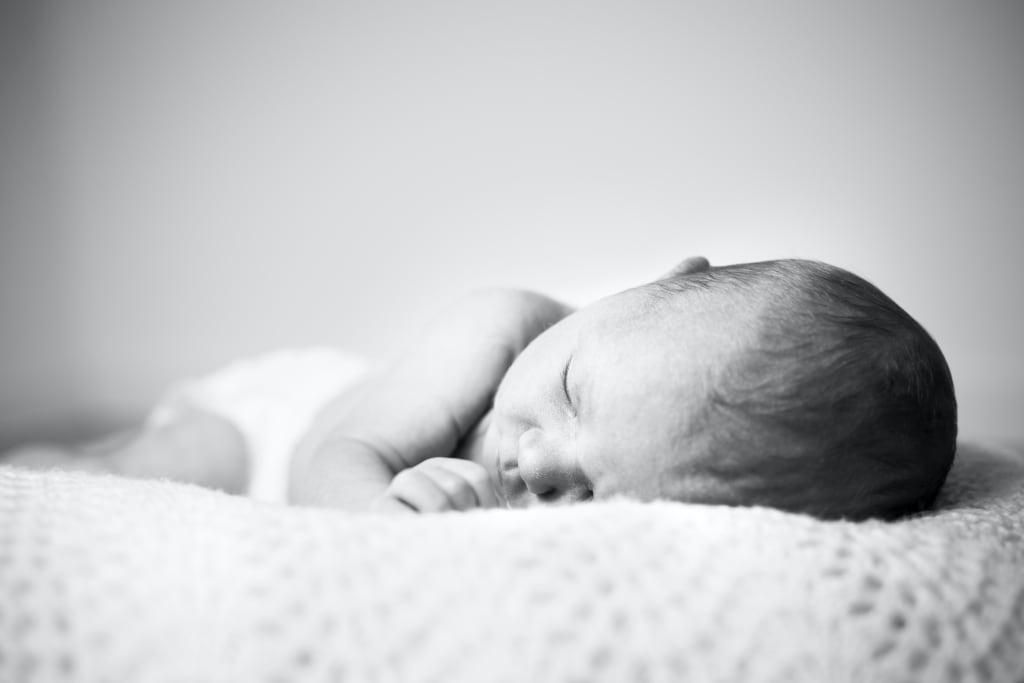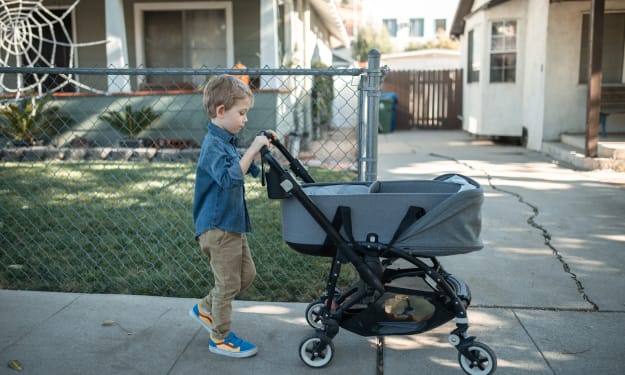
A Nap A Day
Ahhh... sweet parental bliss; yeah the calm days don't actually start until around month 4, after that you have just a couple of silent hours to yourself. However, as a new mom, I didn't exactly set up nap time easily. How could I have messed up setting naptime schedules?? In the sense that I didn't do any at all.... #frowny face.
Nope. I had so much anxiety and panic about this sweet little newborn, that I completely decided against solo napping. I had no idea the sweet little trap that I was setting for myself.
While it is true that setting a "Nap Schedule" up for a newborn is not always possible, putting your child down to sleep alone is. I did not do that. I held my son for his entire nap, every nap up until he was three months old. Was I being paranoid? Yes.
I was so worried about SIDS, or him getting scared because he was alone. In hindsight, my theory wasn't wrong it was just in need of adjustment. That is why I'm writing this.
It's Been a Hard Day's Nap
So how do I wish I had done naptime? Well, here's what happened with how I did things, to begin with.
Firstly, my son cried for so long the first time I put him down for a nap. I nursed him, gave him his bottle, and read him a story/sang to him, and then laid him down. He cried for an entire hour before he finally conked out. I would go in every 15-20 minutes just to reassure him that I was still there and I wasn't leaving him. It didn't matter, he was crying and he was mad. That cycle continued for about three weeks. I stuck to my game and didn't falter. I kept the routine in place and adjusted it where I thought improvement could be found.
The thing is, many babies usually cry when first put down for a nap. Usually, it's just 5-10 minutes of crying; in my son's case, he still cries for 20-30 minutes before he finally falls asleep or "Gives up" for a better word. His little tears just hurt my heart, but it's important for him to be confident that I will come back.
It wasn't just napping where he had trouble, it was sleeping alone PERIOD. At about two months he started sleeping for at least 6 hours, but he was also having teething trouble so the Tylenol at night certainly helped him sleep.
They recommend that baby sleeps in the same room as the parents until they are 1 year old. I plan on having my son sleeping in his crib in the nursery at 6 months. Around that age, he will weigh 15 pounds or close to it and will no longer be able to sleep in the Pack N Play Bassinet. I know... but moving his crib into our room would completely disrupt the strong nap routine I've already built and enforced. His room is right across the hall from ours and with the baby monitor I can see and hear everything. If it doesn't work, he can just sleep in the bottom part of the pack n play without the bassinet attachment. I'll cross that bridge when I come to it though.
If you're thinking about what your set-up for bedtime/naptime is going to be consider these options.
- Buy a Mini Crib instead of a full-size crib
If you're limited on space having a mini crib can help as a space saver. For instance, if you live in a one-bedroom apartment a Mini Crib can fit nicely in your bedroom. They usually also cost less. Unlike regular cribs that are 4-1 convertible, many Mini-Cribs that convert do convert to a toddler bed but the side rail has to be purchased separately in most cases. Always check the items included in the purchase when choosing a mini crib as some come with a side rail and others do not.
Downsides:
- Cannot be converted into a full-size bed headboard/footboard (For later use- Saves you money because you only need to buy a full mattress and frame.)
- Needs a specific mattress (A Mini-Crib must have a Mini Mattress)
- Some brands require a conversion kit for Day Bed or Toddler bed setup
Positives
- A mini Crib is smaller and could fit into a bedroom for the whole duration of your baby's first year.
- Converts into a toddler bed and twin size bed headboards
- Smaller space is taken up which is great for small houses, one-bedroom apartments, or loft apartments with shared spaces.
- Less space is taken up in general
2. Buy a Full-Size Crib and a Pack N Play
If you're living in a house with a separate bedroom that your baby will eventually sleep in by themselves then having a Crib and a Pack n Play can be very beneficial. Note that when you purchase a pack n play, you don't need the portable bassinet that some of the pack n plays come with. Your baby only fits in the portable bassinet for a short period of time before eventually moving on to the bassinet that hangs inside the pack n play.
Downsides
- Need separate sheets for regular size crib and Pack-N-Play
- Larger space is needed for regular size crib
- Harder to change sheets
- Some Baby Monitor Camera's may not be able to see the whole crib from a bird's eye view
- Some brands require a conversion kit for day bed/toddler bed setup
Positives
- Separated sleeping/napping spaces (Baby can take naps early on in the crib, in the nursery giving you the freedom to move around the house)
- Pack-N-Play is smaller than a Mini-Crib and is perfect for co-sleeping in the parent's room. (A Pack-N-Play will fit really well beside a full or queen size bed)
- Pack-N-Play can later be used as a "Safe Play Space" while you're doing housework, cooking, or working from home. (Bassinet feature can only be used until the baby is 15 pounds. Regular size babies usually hit 15 pounds around 5-6 months old. If your baby is on the bigger size they may hit this weight restriction earlier.)
Because I did not start a nap routine early, I now struggle with getting my very "Clingy" baby to nap alone, and I say that with love. While newborns usually don't have a nap schedule, giving them some time to nap alone is important for their confidence. Newborn babies usually sleep for 2-4 hours before they need to wake up to eat. They do this pretty consistently throughout the day and night. Breastfeeding can cause your baby to become drowsy already, so be sure you're giving your little one plenty of time to nurse and get full. I've been 50/50 Breastfeeding and Bottle feeding and that works well for our family. I make milk but not enough to fully fill my babies belly. During the day laying baby down to sleep two or three times can greatly help their confidence.
You can break up naptime if you like by holding baby for the first 30 minutes of the nap letting him/her nurse and sleep and then laying your baby down for the last leg of the nap. Eventually you'll want to start putting them down when drowsy. If you want to.
I quite enjoy holding and rocking my little boy to sleep at night, I get to snuggle him close and his nuzzles me. When I lay him down he rolls over onto his tummy, sticks his butt up in the air and goes to sleep. Around two to three months you will want them to learn that it's okay to go to sleep. I missed that memo; however, it has turned itself around pretty quickly. Just watch your baby for cues like yawning, rubbing their eyes, fussiness or cranky moods and when you see those signs start your pre nap routine whatever it might be. Babies sleep best on full tummies, and relaxed settings.
My son drinks a 4 ounce bottle before his first nap of the day and then nurses after he wakes up. He usually sleeps a little more during nursing. So cute. Your baby may have a different time schedule though, so go with the flow when you first start.
If you begin having your newborn take naps in their crib alone please ensure you can see/hear your baby or consistently check on them from time to time. Before 4-months old the SIDS risk is rather high, so always follow the safe sleep guidelines.
1. Always place your baby to sleep on their back
2. Take any stuffed animals, blankets, pillows, swaddles, and toys out of your baby's crib during sleep or unsupervised time. This includes security blankets.
3. Only swaddle your baby during sleep until they can roll over on their own or begin showing signs they are trying to roll over. (Keeping babies swaddled if they can roll over could result in suffocation)
Babies know they are vulnerable, so they rely on the mother to keep them safe. This is why most newborns don't sleep well when alone, and often want to be walked or have the parent standing. A parent is much more likely to run from danger successfully if already standing and deep down, babies know this.
Hold your little newborn as much as possible, but remember to allocate a few hours out of the day where the baby sleeps in the crib alone. Having a baby monitor to see your little one can help a lot with the nervous feeling of leaving your sweet one alone.
I always make sure the room is cool/warm enough, in the summer I have a fan that blows against the wall to keep the air flowing throughout the room. Babies sleep best with temperatures between 70-72 degrees according to the internet.
I make sure the fan isn't blowing directly on my son or he could get too cold. I play his lullabies during naptime and this seems to help him sleep during the day. I love the lullabies by Cedarmont Kids. It's a mix of traditional lullabies and Christian lullabies. I also have Raffi and a few other kids' songs that he enjoys, but lullabies are best for naptime. He doesn't use his HATCH for naptime, just bedtime and I do that so he can distinguish between long sleep and short sleep.
I keep the room dark as possible right now.
Newborn babies still don't have the insight to know day/night cycles so your little sweetie may be thinking it's nighttime when it's actually daytime.
The Final Naptime
Getting to the nap zone is all about timing. The recommended time between naps for 3-6-month-olds is 1 hour to 2.5 hours, however, my son is an every 3-hour napper. He sleeps quite well at night, going 8-10 hours for sleep. Another reason he might not be ready to sleep is if he didn't get enough activity. So in between naptime he:
- Plays in his Baby Einstein 4-1 Kickin' Tunes Activity Center
- Swings in his Graco DuetConnect LX Swing or bounces in the portable bouncer. He often watches Baby Einstein while sitting in his bouncer. He loves the puppets.
- We also do playtime together
- Your baby can also swim as early as 3-months but be sure to wash them afterward.
Getting my son to the two-hour nap mark takes a lot of hard work, mostly emotionally. It's really hard to not run and snuggle your baby when they cry, and while you SHOULD go into the nursery and smile, tell them you love them and touch their hand every 15-20 minutes; you should not run in every time they cry. In order for them to learn that they are safe, they need to know that you will come back. Matthew now just sighs and smiles when he wakes up because I'm always there when he does. When we first started though, he cried bloody murder every time he woke up and I wasn't right there.
Babies rely heavily on eye contact, facial expressions, and touch. So smiling at your baby when you check on him, looking him in the eye, and touching his hand, all reassure him that it's safe and he/she doesn't need to be scared. For first naps 30 minutes is about what babies will sleep for, newborns may sleep for an hour or two but 2-months to 3-months can sleep anywhere from 30 minutes to an hour for naps. If your first few naps go 30-minutes call it a win, smile at your baby, kiss them and encourage the great nap!
My son still hasn't gotten sleeping early down, so he falls asleep around 11:30 pm-12:00 am and won't sleep any sooner than that. I think that has to do with how long he sleeps at night. His sleep pattern might change when he starts sleeping in the nursery though.
Until then, I will continue on this Nap Journey! I hope the few things I've written here help anyone who is currently struggling with naptime.
About the Creator
Shiny
I am a writer, author and painter. I have a Master's degree in Creative Writing and love writing about all kinds of topics.






Comments
There are no comments for this story
Be the first to respond and start the conversation.